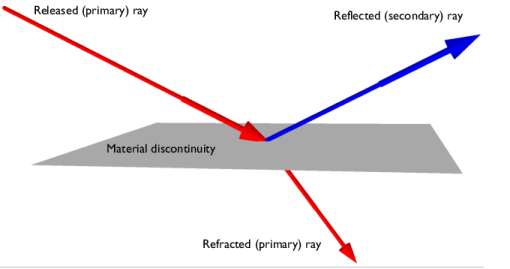In the Geometrical Optics interface, rays are designated as either primary or
secondary. Similarly, the physics features that produce them are called
primary release features or
secondary release features. The above is an example of a secondary release.
For example, the following diagram shows an incident ray being split into reflected and refracted rays at a Material Discontinuity where the refractive indices on either side differ. The Geometrical Optics interface always applies deterministic ray splitting at such boundaries, so when one ray reaches the surface, two rays emerge from it. The refracted ray is a continuation of the incident ray because it has the same index and uses the same degrees of freedom. The reflected ray is a secondary ray.
Similarly, the Grating boundary condition can release both reflected and transmitted rays of many diffraction orders. One of these reflected or transmitted rays uses the degrees of freedom of the incident ray, and the rest must be taken from the preallocated secondary degrees of freedom.
